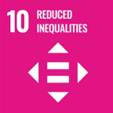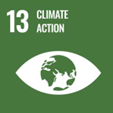Departmental Sustainable Development Strategy Report 2024 to 2025
About Us
Vision
Everyone, including people with disabilities:
- can expect a Canada without barriers
- be sure that opportunities and services are fully accessible
Mission
People with disabilities lead Accessibility Standards Canada to create a Canada without barriers. We work with people with disabilities to:
- create transformational accessibility standards in priority areas
- revise current accessibility standards
- lead and fund research
- support society to reach the highest level of accessibility
Values
Our values are based on the principles stated in the Accessible Canada Act. We value:
- The knowledge and experience of people with disabilities. We expect those we collaborate with to share this same value.
- The diversity of society. Our work respects human rights and focuses on including everyone.
- A Canada without barriers where people with disabilities can expect the same high level of access across the country.
- Universal access, where services, products, and places are designed to be accessible to everyone.
- Two-way communication in all areas of our work. Communication must be open, accessible, timely, and clear.
- Lived experience of disability and research as equally important when making decisions.
Introduction to 2024 to 2025 Report
The 2022 to 2026 Federal Sustainable Development Strategy (FSDS) presents the Government of Canada’s Sustainable Development Goals (SGDs) and targets. Setting targets is a requirement of the Federal Sustainable Development Act. This Act aims to make decision-making in this area more transparent and accountable to Parliament. It also provides a balanced view of the environmental, social, and economic dimensions of sustainable development. It supports Canada’s efforts to advance the 17 sustainable goals developments of the United Nations’ 2030 agenda for sustainable development.
Accessibility Standards Canada supports the goals laid out in the FSDS. We also support the intent of the Federal Sustainable Development Act. We demonstrate this support through the activities described in our 2023 to 2027 DSDS.
The purpose of this report is to document the progress we made in the 2024 to 2025 fiscal year toward implementing our 2023 to 2027 DSDS.
The Federal Sustainable Development Act sets out 7 principles that must be considered in the development of both the federal strategy and departmental strategies. These principles therefore apply to our 2023 to 2027 DSDS and this 2024 to 2025 progress report.
Our departmental strategy is part of coordinated actions on sustainable development across the federal government. It reports on progress in implementing Canada’s National strategy for the 2030 agenda and in advancing the SGDs. These goals are supported by the targets and indicators set out in the Global indicator framework and the Canadian indicator framework.
This report captures our progress on initiatives related to the sustainable goals developments that fall outside the scope of the federal strategy.
Commitments for Accessibility Standards Canada:
Goal 10: Advance Reconciliation on Indigenous Peoples and Take Action on Inequality
FSDS Context:
This goal focuses on reducing inequalities within First Nations, Inuit, and Métis communities.
Our mandate is to develop standards that address accessibility barriers for all Canadians with disabilities. To do this, we draw on the experience and expertise of people with disabilities from across the country. Our work includes recognizing the unique history of Indigenous Peoples. We are also aware there are individuals with disabilities who are Indigenous.
When we engage with our partners, we apply an intersectional lens. This means we recognize that everyone’s identity is made up of multiple, intersecting factors. We also work to ensure our standards development and review processes are open and inclusive.
Accessibility Standards Canada developed a strategy to help implement the United Nations Declaration on the Rights of Indigenous Peoples Act. It includes:
- increasing research funding for Indigenous-specific accessibility issues
- conducting tailored outreach and engagement activities
- increasing the cultural awareness of our staff
These actions will help us build bridges and put us on a path toward reconciliation with Indigenous Peoples. This is in line with Federal sustainable development (Goal 10).
Target theme: Advancing reconciliation with Indigenous Peoples, including First Nations, Inuit, and Métis communities.
Target: Between 2023 and 2026, and every year thereafter, we will annually report on our progress toward implementing the United Nations Declaration on the Rights of Indigenous Peoples Act.
Table 1: Advancing Reconciliation with Indigenous Peoples, including First Nations, Inuit, and Métis Communities.
Table 1 below provides details on the actions we are taking to advance reconciliation with Indigenous Peoples.
| Implementation strategy | Departmental action | Performance indicator | Starting point | Target | Contribution to the FSDS goals and Canada’s 2030 agenda | Results achieved as of March 31, 2025 |
|---|---|---|---|---|---|---|
Support the United Nations Declaration on the Rights of Indigenous Peoples Act. | Action 1: Increase funding for Indigenous-focused accessibility research projects. | Percentage of research funding dedicated to Indigenous focused accessibility research projects. | A total of 2% of research funding was being allocated to such projects as of March 31, 2023. | During the 2025 to 2026 fiscal year, we will allocate 4% of research funding to Indigenous-focused accessibility research projects. | Increasing funding to research Indigenous-specific accessibility issues will reduce inequalities for Indigenous people living with disabilities. Canadian indicator framework ambition (Goal 10): Canadians live free of discrimination and inequalities are reduced. This action aligns with Canadian indicator framework 10.2.1: Proportion of the population reporting discrimination or unfair treatment. It also aligns with the Global indicator framework 10.3 target: Ensure equal opportunity and reduce inequalities of outcome. This includes eliminating discriminatory laws, policies, and practices. It also includes promoting appropriate legislation, policies, and actions. | In the 2024 to 2025 fiscal year, a total of 14% of research funding had been allocated to Indigenous-focused accessibility research projects. |
Support the United Nations Declaration on the Rights of Indigenous Peoples Act. | Action 2: Execute a mandatory Indigenous awareness training program for all employees. | Percentage of employees who have attended mandatory Indigenous awareness training. | As of April 1, 2023, 25% of our employees had been trained. | By March 2026, we will have trained 100% of employees. | This action is meant to increase cultural awareness of issues related to First Nations, Inuit, and Métis people in Canada. Increasing understanding of the unique history and rights of Indigenous Peoples will improve the cultural sensitivity of our employees. It will also empower them with the skills needed to implement the United Nations Declaration on the Rights of Indigenous Peoples Act. Canadian indicator framework ambition (Goal 10): Canadians live free of discrimination and inequalities are reduced. As with action 1 (above), this contributes to the Canadian framework indicator 10.2.1 and the Global indicator framework 10.3.1: Proportion of the population reporting discrimination or unfair treatment. This includes the proportion of people who say they personally experienced discrimination or harassment in the past 12 months because of a reason that is prohibited under international human rights law. | As of March 31, 2025, 55.93% of staff had received Indigenous awareness training.
|
Table 2: Initiatives Planned to Reduce Inequalities.
Table 2 below provide details on the initiatives planned to reduce inequalities.
| Planned initiatives | Associated domestics targets or ambitions and global targets | Results achieved as of March 31, 2025 |
|---|---|---|
We continue to seek partnerships to advance the development of accessibility standards. During the 2024 to 2025 fiscal year, we developed new and strengthen relationships on a national and international level. | These partnerships are vital to removing inequalities. This aligns with United Nations Sustainable Development (Goal 17): Revitalize the global partnership for sustainable development. | During the 2024 to 2025 fiscal year, we achieved the following:
|
A total of 11 standards were under development during the 2024 to 2025 fiscal year:
| These standards will reduce inequities, as highlighted in the Global indicator framework 10.3.1. In addition, they will support the safety and well-being of Canadians with disabilities. For people with disabilities, these standards will enable safe access to buildings and outdoor spaces. They will also improve access to services and the delivery of goods. This contribution is highlighted in the Global indicator framework 11.7.1. | During the 2024 to 2025 fiscal year, we:
|
Accessibility Standards Canada drafted a technical guide on accessible-ready housing. The objective of this guide is to help provinces and territories develop housing that will support aging in place. This includes housing in Indigenous communities. This will support people with disabilities. | This guide contributes to United Nations Sustainable Development (Goal 10): Reduced Inequalities. The Canadian indicator framework for Federal Sustainable Development (Goal 10) refers to the need to eliminate inequities. It also refers to Canadians being able to live free of discrimination. This includes everyone, regardless of age; gender; disability; race, ethnicity, or origin; religion; or other economic or social factors. | A decision was made to develop a standard instead of a guide. Accessible ready-housing standard is expected to be published during the 2025 to 2026 year. |
Goal 12: Reduce waste and transition to zero-emission vehicles
FSDS Context:
Proper management of waste, resources, and chemicals requires responsible consumption. Responsible consumption is an attitude. It involves making well-reasoned decisions about the products we buy. It means considering a product’s environmental, social, and economic benefits. The aim of sustainable consumption and production is to “do more and better with less.” This will increase the net benefit of economic activity. Reducing resource use also reduces environmental degradation and pollution.
Accessibility Standards Canada has adopted the federal government’s green procurement policy. This aligns with the general procurement policy for the federal public service. We are working toward buying more recycled materials. There are recycling bins in the office for staff use. In addition, our faucets and lighting fixtures are automated. This reduces unnecessary water and electricity usage.
Target theme: Management of waste, resources, and chemicals.
Target: Reduce the amount of waste Canadians send to disposal from a baseline of 699 kg per person in 2014 to 490 kg per person by 2030 (a 30% reduction), to 350 kg per person by 2040 (a 50% reduction). This target was set by the Minister of Environment and Climate Change, the federal lead in the Canadian Council of Ministers of the Environment.
Table 3: Management of Waste, Resources, and Chemicals.
Table 3 below provide details on the actions to reduce management of waste, resources, and chemicals.
| Implementation strategy | Departmental action | Performance indicator | Starting point | Target | Contribution to the FSDS Goals and Canada’s 2030 Agenda | Results achieved as of March 31, 2025 |
|---|---|---|---|---|---|---|
Strengthen green procurement criteria. | Identify procurement and similar specialists needing training in green procurement. Have these specialists take a training course on green procurement, such as the course offered by the Canada School of Public Service. Ensure they are trained within 1 year of being identified. | Percentage of procurement specialists who received training within 1 year of being identified. | A total of 50% had been trained as of April 1, 2023. | 100% of procurement specialists receive training within 1 year of being identified as of March 2025. | Ambition Canadian framework indicator (Goal 12): Canadians consume in a sustainable manner. This action aligns with Canadian framework indicator 12.2.1: Proportion of businesses that adopted selected environmental protection activities and management practices. It also aligns with the Global indicator framework 12.7: Promote public procurement practices that are sustainable, in accordance with national policies and priorities. | All (100%) of procurement specialists have received training on green procurement within 1 year of being identified. |
Table 4: Planned Initiatives to Reduce Waste.
Table 4 below provide details on the action initiatives planned to reduce waste.
| Planned initiatives | Associated domestics targets or ambitions and global targets | Results achieved as of March 31, 2025 |
|---|---|---|
Accessibility Standards Canada is currently developing a standard on the Design and delivery of accessible programs and services. Its objective is to ensure that people with disabilities can access the goods and services that accommodate their needs. Designing products for people with disabilities is an opportunity to embrace diversity. It also drives innovation and creates a more inclusive society. The consumers of these products and services are considered and involved at every stage of the service and product production cycles. By incorporating user-centric, accessible, and universal design principles, businesses can create products that resonate with a larger and more diverse audience. This will increase the social impact and the bottom line of businesses. It will also improve inclusivity and sustainability and reduce waste. | This standard contributes to Canadian indicator framework 12.2.1: Proportion of businesses that adopted selected environmental protection activities and management practices. | The public review of the Design and delivery of accessible programs and services including customer service began in February 2025. In addition, Accessibility Standards Canada’s technical committee began development of the Accessible procurement standard in November 2024. The objective of the standard is to ensure:
Our office space was created using universal design principles. It has become a model for other federal government agencies. Increasingly, these agencies are looking to our model to inspire their own workspace designs. |
Goal 13: Take Action on Climate Change and its Impacts
FSDS Context:
Federal sustainable development (Goal 13) advocates for action to combat climate change and its impacts. Climate change is now affecting every country on every continent. It is disrupting national economies and affecting lives. It is costing people, communities, and countries dearly.
Recent storms, fires, and mudslides are a reminder that urgent action is needed to address climate change. Accessibility Standards Canada is committed to developing standards that not only address accessibility barriers, but also mitigate climate change and its impacts, particularly impacts on people with disabilities.
Target theme: Adapting to and mitigating climate change.
Target: By 2030, reduce greenhouse gas emissions by 40% to 45% below 2005 levels. By 2050, achieve net-zero greenhouse gas emissions.
Accessibility Standards Canada does not own a fleet of vehicles; however, we are adopting policies that help reduce greenhouse gas emissions.
Table 5: Adapting to and mitigating climate change.
Table 5 below provide details on the actions in adapting to and mitigating climate change.
| Implementation strategy | Departmental action | Performance indicator | Starting point | Target | Contribution to the FSDS Goals and Canada’s 2030 Agenda | Results achieved as of March 31, 2024 |
|---|---|---|---|---|---|---|
Implement the Greening Government Strategy. We do this by putting measures in place that:
| Action 1: Identify employees that need to be trained on climate change. Action 2: Within 1 year of being identified, train these employees on climate change. This will include training on assessing impacts, undertaking risk assessments, and developing adaptive actions. | The percentage of identified employees that have been trained on climate change. | Zero employees trained as of April 1, 2023. | 100% trained by March 31, 2026. | Trained staff can:
Canadian indicator framework ambition (Goal 13): Canadians are well equipped and resilient to face the effects of climate change. This action aligns with Canadian indicator framework 13.3.1 and Global indicator framework 13.3: Proportion of municipal organizations that factored climate change adaptation into decision-making processes. This includes efforts to improve education, awareness-raising, and human and institutional capacity on climate change mitigation, adaptation, impact reduction, and early warning. | The organization identified which staff need climate change training, and 33% of them have completed it. |
Table 6: Planned action to the Climate Change Mitigation and Adaptation.
Table 6 below provide details on the action planned to the climate change mitigation and adaptation.
| Planned Initiatives | Associated domestics targets or ambitions and global targets | Results achieved as of March 31, 2024 |
|---|---|---|
Accessibility Standards Canada is a federal leader in creating a sustainable and accessible office space. Our space uses universal design principal. This ensures the space is safer and more flexible. It is also more accessible for employees of varied ages and abilities. Our office space has automated lighting and water faucets, reducing water and electricity usage. We have also adopted a hybrid working policy. This reduces staff commuting time, which lowers the emission of greenhouse gases and vehicular carbon. | These actions correspond to the Canadian indicator framework 13.1.1. This target advocates for urgent action to reduce greenhouse gas emissions. | We continue to maintain an environmentally friendly office space. We also continue to follow the hybrid working policy adopted by the federal government. This lowers the emission of greenhouse gases and vehicular carbon emissions. |
Integrating Sustainable Development

Accessibility Standards Canada will continue to ensure that its decision-making process includes consideration of FSDS goals and targets through its Strategic Environmental Assessment (SEA) process. A SEA for a policy, plan or program proposal includes an analysis of the impacts of the given proposal on the environment, including on relevant FSDS goals and targets.
Public statements on the results of Accessibility Standards Canada’s assessments are made public when an initiative that has undergone a detailed SEA. The purpose of the public statement is to demonstrate that the environmental effects, including the impacts on achieving the FSDS goals and targets, of the approved policy, plan or program have been considered during proposal development and decision making.
Accessibility Standards Canada did not complete any detailed SEAs in 2024 to 2025.



